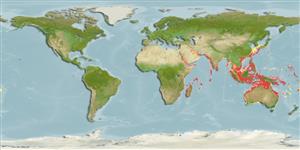>
Ovalentaria/misc (Various families in series Ovalentaria) >
Pomacentridae (Damselfishes) > Pomacentrinae
Etymology: Pristotis: Greek, pristis = saw + Greek, ous, otis = ear (Ref. 45335).
More on author: Günther.
Environment: milieu / climate zone / depth range / distribution range
Sinh thái học
Biển Cùng sống ở rạn san hô; không di cư; Mức độ sâu 2 - 80 m (Ref. 9710). Tropical
Indo-West Pacific: Red Sea and Persian Gulf to the Ryukyu Islands, Taiwan, Indonesia, New Guinea, and northern Australia.
Bộ gần gũi / Khối lượng (Trọng lượng) / Age
Maturity: Lm ? range ? - ? cm
Max length : 14.0 cm TL con đực/không giới tính; (Ref. 9710)
Các tia vây lưng cứng (tổng cộng) : 13; Các vây lưng mềm (tổng cộng) : 12 - 13; Tia cứng vây hậu môn: 2; Tia mềm vây hậu môn: 12 - 14.
Usually identified as P. jerdoni (Day, 1873), a junior synonym (Ref. 48636). Adults are found mainly along continental margins rather than truly oceanic areas. Inhabits flat sandy or rubble bottoms around patch reefs of lagoons and trawling grounds (Ref. 7247). Adults often seen in small groups out in the open on sandy substrate, swimming well-above the bottom and unlike other damselfishes rely on speed to get away from predators rather than diving into the shelter or reefs or burrow. Juveniles often shallow estuaries, but adults mainly in deeper water offshore at depths of 20+ m and have been reported to 80 m depth (Ref. 48636). Oviparous, distinct pairing during breeding (Ref. 205). Eggs are demersal and adhere to the substrate (Ref. 205). Males guard and aerate the eggs (Ref. 205). Diurnal species (Ref. 54980; 113699).
Life cycle and mating behavior
Chín muồi sinh dục | Sự tái sinh sản | Đẻ trứng | Các trứng | Sự sinh sản | Ấu trùng
Oviparous, distinct pairing during breeding (Ref. 205). Eggs are demersal and adhere to the substrate (Ref. 205). Males guard and aerate the eggs (Ref. 205).
Randall, J.E., 1995. Coastal fishes of Oman. University of Hawaii Press, Honolulu, Hawaii. 439 p. (Ref. 11441)
IUCN Red List Status (Ref. 130435: Version 2024-1)
Threat to humans
Harmless
Human uses
Các nghề cá: Các nghề cá là sinh kế; Bể nuôi cá: Tính thương mại
Các công cụ
Special reports
Download XML
Các nguồn internet
Estimates based on models
Preferred temperature (Ref.
123201): 24.3 - 29, mean 27.8 °C (based on 1240 cells).
Phylogenetic diversity index (Ref.
82804): PD
50 = 0.7500 [Uniqueness, from 0.5 = low to 2.0 = high].
Bayesian length-weight: a=0.01549 (0.00794 - 0.03021), b=2.98 (2.81 - 3.15), in cm total length, based on LWR estimates for this species & (Sub)family-body (Ref.
93245).
Mức dinh dưỡng (Ref.
69278): 3.5 ±0.51 se; based on food items.
Generation time: 1.4 ( na - na) years. Estimated as median ln(3)/K based on 1
growth studies.
Thích nghi nhanh (Ref.
120179): Chiêù cao, thời gian nhân đôi của chủng quần tối thiểu là dưới 15 tháng (K=0.8).
Fishing Vulnerability (Ref.
59153): Low vulnerability (17 of 100).
Nutrients (Ref.
124155): Calcium = 96.2 [61.6, 162.0] mg/100g; Iron = 0.898 [0.580, 1.375] mg/100g; Protein = 18.8 [17.8, 19.8] %; Omega3 = 0.173 [0.110, 0.267] g/100g; Selenium = 29.6 [17.4, 52.9] μg/100g; VitaminA = 163 [64, 410] μg/100g; Zinc = 1.49 [1.04, 2.02] mg/100g (wet weight);
